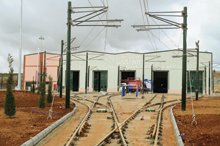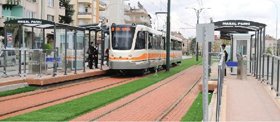The Planned Light Rail System
Objectives and Policies
 The construction of the light rail system began in 2007 and the first stage of the initial line became operational in the beginning of 2010 under the responsibility of the Gaziantep Metropolitan Municipality. The initial line of the Gaziantep rail system was to be implemented in two stages. The first section of the initial line was included in the stretch between Depot (Terminal station) and the Main Railway Station in city centre.
The construction of the light rail system began in 2007 and the first stage of the initial line became operational in the beginning of 2010 under the responsibility of the Gaziantep Metropolitan Municipality. The initial line of the Gaziantep rail system was to be implemented in two stages. The first section of the initial line was included in the stretch between Depot (Terminal station) and the Main Railway Station in city centre.
The light rail system has been integrated with the other transportation systems and each of the transportation modes is operational as a part of the total system. Care has been taken to protect the urban environment from the negative effects of the operations. Priority has been awarded to general traffic and easy accessibility in the rail system.
Definition of the Route
 The proposal was to construct a rail line beginning from southern residential areas and reaching the city centre via University and then linking the centre and the industrial areas in the east. This urban rail line, designed at the surface with physically separated right-of-way, has priority at signals of the level crossings with the other traffic.
The proposal was to construct a rail line beginning from southern residential areas and reaching the city centre via University and then linking the centre and the industrial areas in the east. This urban rail line, designed at the surface with physically separated right-of-way, has priority at signals of the level crossings with the other traffic.
The first stage of the Gaziantep Railway System Line described in this section is located on the 15km long portion between Terminal-University-City Centre. Planned as a two-direction typical street tramway system, it consists of 18 stops and one storage-maintenance-repair facility with adequate system capacity to fulfill the expected passenger demand in the target year – 2025.
Passenger Volumes
In the plan, a total number of morning peak hour passengers was projected as 14,441 in 2010, 19,159 in 2015, 23,402 in 2020 and 30,406 in 2025. A total of 10,742 inbound passengers from the direction of Bağlarbaşı to Meydan were supposed to use the rail system in year 2010. The number is expected to rise to 16,866 in 2020 and to 21,887 in 2025.
The passenger volume increases from Karataş for inbound trips and reaches the highest volumes on the section between Kavaklık and Hospital Stops with an additional boarding in 2010 and 2015. Total passengers on this section reached 7,745 in 2010 and are expected to reach 10,533 in 2015, 11,220 in 2020 and 13,823 in 2015. The highest passengers’ section will be between Fidanlık and Öğretmenevleri Stops in 2020 with 11,388 passengers and 2025 with 14,353 passengers.
Outbound passenger loads of the line were lower with 3,599 passengers in 2010. They are expected to be lower in 2020 (with 6,536 passengers) and 2025 (with 8,519 passengers) as well.
Important Decisions
Modification of the Line
 After preparing the feasibility for the planned light rail system, the Gaziantep Metropolitan Municipality tried to use some loans or credits to construct the infrastructure. Unfortunately, the Government Planning Organisation which has the responsibility of taking decisions on the railway systems in the city centres, did not permit Gaziantep Municipality to start the construction. The municipality couldn’t find the finance for a light rail system.
After preparing the feasibility for the planned light rail system, the Gaziantep Metropolitan Municipality tried to use some loans or credits to construct the infrastructure. Unfortunately, the Government Planning Organisation which has the responsibility of taking decisions on the railway systems in the city centres, did not permit Gaziantep Municipality to start the construction. The municipality couldn’t find the finance for a light rail system.
After recognising that the planned light rail system would never be constructed under the current situations, the municipality decided to construct the line by using its own finances and changed the light rail system to a tramway line which was to be the first rail public transport in the city. The technical team divided the project into two steps, 9.3km and 13 stations for the first step and remaining part in the second step which will be built after the new finance resources are found. The terminal is moved to another land which stands in the middle of the first planned line but at the second station of the modified line.
Purchasing Second Hand Trams
This new tram line has 15 trams which are greener and cheaper than those of the other cities because the city has ‘’recycled’’ the trams of Frankfurt, Germany by completely renovating them locally. The access doors have been widened and air conditioning has been installed. The purchase of these second hand trams has, to a big extent, helped to decrease the overall costs by reducing the part of vehicles by 18.83% (including the modification of the vehicles) of the total budget. The cost of vehicles in a light rail system normally constitutes 50% of similar projects in the other cities of Turkey.
Splitting the Tender
Without presenting one large call for tenders and dividing the project into infrastructure, vehicles & electrification and signaling systems, the Municipality has decided to complete the project and go for the best market prices in Turkey. The result is a price of nearly €4.6 million per kilometre, approximately six times cheaper than the price in the rest of Europe.
The overall costs for the trams and purchase of parts, modification of the trams, electrification and track system, construction of the infrastructure, construction and the equipments of the terminal area and the various works comes to €43.093.615,41.

Taking two lanes of traffic for tramway
 The tram line is also decided to be constructed on the at-grade in the middle of an important arterial which witnesses traffic congestion at peak hours. Some protestors tried to stop this and took the matter to the court. They were waiting to protest the opening of the project because they believe that the trams will lead to huge congestion once they become operational.
The tram line is also decided to be constructed on the at-grade in the middle of an important arterial which witnesses traffic congestion at peak hours. Some protestors tried to stop this and took the matter to the court. They were waiting to protest the opening of the project because they believe that the trams will lead to huge congestion once they become operational.
The tramway line is operating since the last four months and there has been no traffic congestion at all. The capacity of passenger is, on an average, 25,000 passengers per day. The users are satisfied especially when it comes to the travel time and comfort standards.
After recognising that the planned light rail system would never be constructed under the current situations, the municipality decided to construct the line by using its own finances and changed the light rail system to a tramway line which was to be the first public transport in the city.
As the public resources are very limited all over the world, the style adopted for the project will be a good example for all municipalities. The division of the tender into different smaller parts has increased the competition and participants. As a result the Municipality has obtained very reasonable offers. All Municipalities have, in fact, difficulties in finding resources. The Gaziantep tramway project will be a model for the countries that are planning to have rail systems for public transportation but are scared of bearing the overall costs. The ‘’recycling’’ of vehicles could be a cheap option to make the transport system cheaper and greener.
(Safak Hengirmen Tercan played a key role in the planning and constructing of areas for several projects with a value of more than €150 million, some of them being implemented for the first time in Turkey. She is the Project Manager of the EU founded “Sustainable Urban Mobility” project implemented in Jordan and Syria for a period of three years.)
 TrafficInfraTech Magazine Linking People Places & Progress
TrafficInfraTech Magazine Linking People Places & Progress


